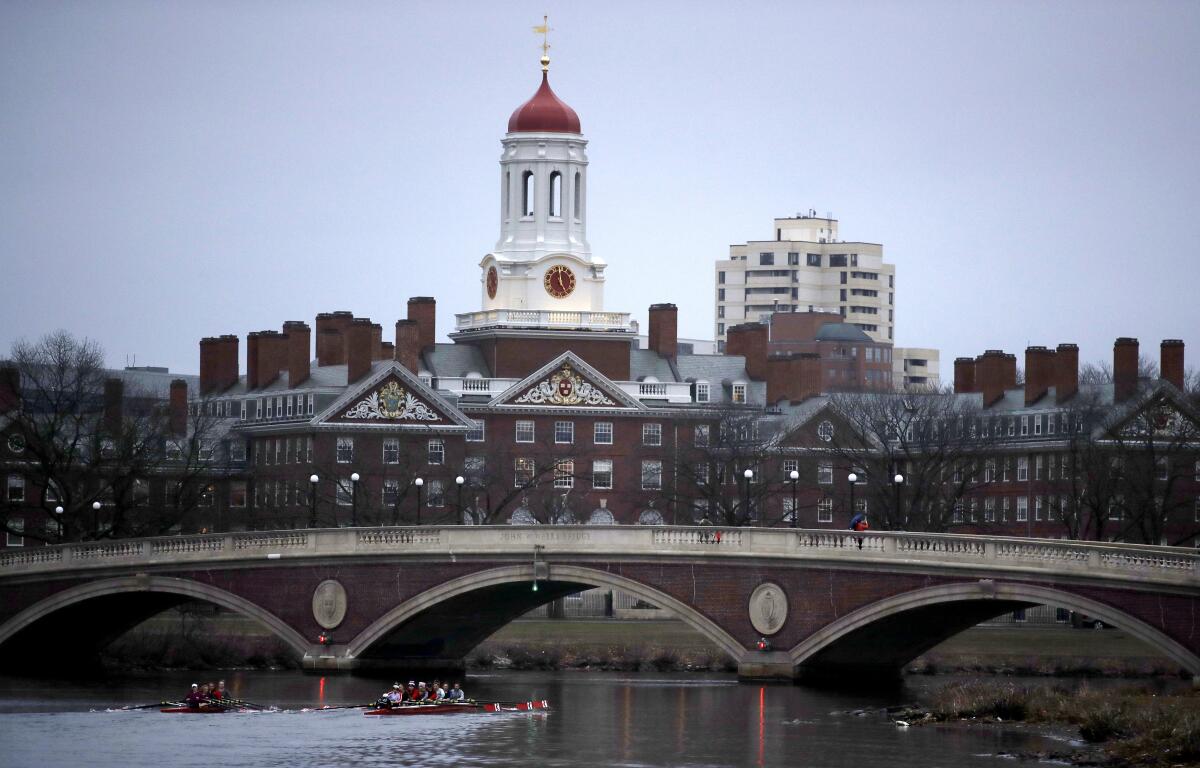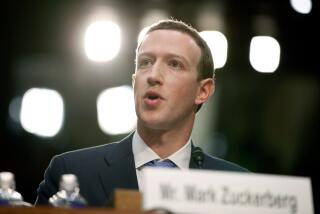Column: With a $300-million donation to Harvard, a hedge fund billionaire shows why we need a wealth tax

- Share via
Harvard University wants us to bow down to the exceptional generosity of Kenneth C. Griffin, a hedge fund billionaire who just made a $300-million gift to the school’s graduate program.
Griffin’s donation to his alma mater “underscores the power of education to transform lives and to expand the reach of our research in every field imaginable,” Harvard President Larry Bacow said in the announcement press release. “It has been a great pleasure to get to know Ken throughout my presidency.”
In return for the money, the program has been renamed the Harvard Kenneth C. Griffin Graduate School of Arts and Sciences.
It has been a great pleasure to get to know Ken throughout my presidency.
— Harvard President Larry Bacow lauds Ken Griffin, one of his university’s biggest donors
We’re not so sure about the rationale for that last part. The program could just as well have been named the U.S. Taxpayer Graduate School, because that’s who almost certainly will be covering at least some of the gift.
Griffin’s donation, you see, is likely to bring him a sizable federal income tax deduction. Its actual size is impossible to calculate without knowing more about Griffin’s specific tax situation. What’s known comes to us from ProPublica, which last July drew from a trove of leaked documents to report on how members of the 0.01% get away with minimizing the tax bite on their enormous wealth.
Get the latest from Michael Hiltzik
Commentary on economics and more from a Pulitzer Prize winner.
You may occasionally receive promotional content from the Los Angeles Times.
Griffin ranked high on ProPublica’s list. The news organization found that he had “averaged an annual income of $1.7 billion from 2013 to 2018,” making him the fourth-highest income earner in the country. His average tax rate was 29.2% in those years, ProPublica reported.
That’s considerably lower than the top marginal tax rate, which currently is 37% on income over about $578,000 for single taxpayers. (Griffin, according to the latest biographical material, is divorced.) On the raw numbers, Griffin may be able to reduce his federal income tax bill by about $110 million through his donation to Harvard. Who would pick up the slack? You and me, that’s who.
Perhaps Griffin has disavowed a tax break from his Harvard gift, though that’s implausible. Indeed, a spokesperson for Griffin acknowledged, as ProPublica reported last year, that his tax rate was “lowered by charitable contributions,” among other factors.
The dirty little secret about how plutocrats finance the charitable deductions that get their names on distinguished institutions is only one aspect of Griffin’s gift that should concern all Americans.
More broadly, it points to the wisdom of a wealth tax on American millionaires and billionaires. As we’ve noted in the past, concentration of wealth on the scale seen in America today would have appalled the Founding Fathers.
The Wall Street Journal says America ‘soaks the affluent.’ Try to hold back your tears.
Thomas Jefferson, for one, advocated “a system by which every fibre would be eradicated of antient [sic] or future aristocracy; and a foundation laid for a government truly republican.”
The rich often defend their accumulated fortunes by ostentatiously doing good with the money through philanthropy. The announcement of a major donation on the scale of Griffin’s is typically accompanied by an accounting of the donor’s other charitable efforts.
Usually, however, what passes for selfless charity is a mask for the rich to fund their personal hobby horses. A classic example of this identified in 2012 by then-Reuters columnist Felix Salmon (now at Axios) was a $100-million gift to the Central Park Conservancy of New York by hedge fund boss John Paulson — who happened to live a few doors down from the park.
“If you wanted to give $100 million to charity while making the barest minimum impact on the world, you’d be hard pushed to improve on Paulson’s performance,” Salmon wrote.
In some cases, big donors get credit for saving institutions from financial quagmires resulting from the sort of tax breaks the donors have enjoyed.
They get credit for funding anti-poverty programs and those to support hospitals, drug rehabilitation clinics, art museums, scientific research laboratories that all should be supported by public funding. Except there isn’t enough funding to go around because the wealthy have been collecting ever-increasing tax breaks for decades.
It’s fair to presume that one purpose of all this eleemosynary activity is to obscure the less uplifting ways that the rich deploy their wealth. One is lobbying to keep and augment their tax breaks.
In 2020, for instance, Griffin contributed $54 million to a campaign fighting an Illinois ballot measure that would have raised the state’s marginal tax rate on incomes higher than $750,000 to about 8% from 5%. ProPublica estimated that the measure could have cost Griffin about $50 million a year. The measure was defeated.
During the campaign, Griffin wrote in an op-ed that this opposition to the tax increase was merely an expression of his civic-mindedness.
The tax measure’s promoters, including Democratic Gov. J.B. Pritzker (also a billionaire) “seek to shift even more hard-earned taxpayer money into the hands of politicians who have consistently proven to be irresponsible stewards,” he wrote. “I’m willing to stand up for what is right.”
Elon Musk and his fellow billionaires are demanding absolute privacy, but given their power over the economy, they deserve an even brighter spotlight.
He wasn’t willing to stay, however. The following year, Griffin moved his family and the headquarters of his Citadel hedge fund and Citadel Securities firm to Miami from Chicago.
Griffin said tax considerations weren’t at issue, but unlike Illinois, Florida has no personal income tax. Since his move, he has become a major financial supporter of Florida Gov. Ron DeSantis. (While living in Chicago, he was a financial backer of former Mayor Rahm Emanuel, a Democrat.)
One particularly questionable category of high-level philanthropy is tax-advantaged donations to rich universities such as, well, Harvard. That ostensibly nonprofit institution has an endowment of more than $50 billion, the largest in the country. On what planet can a taxpayer-subsidized addition to this endowment be justified?
We raised the same issue back in 2016, when Nike founder Phil Knight collected plaudits for making a $400-million gift to Stanford University, where he received a business degree.
Knight got his name on the scholarship program funded by his gift; an earlier donation got his name on a new classroom building on campus.
What was striking then, and remains notable today, was the mismatch between the public funding of elite private universities and public support for even the best public universities.
A 2015 data survey by Nexus Research placed the discrepancy in stark relief by comparing the implicit per-student subsidy at rich private institutions with the government funding of public colleges in their state. In California, it showed that Stanford received about $63,000 per student, while UC Berkeley got $10,500, Cal State Fullerton got $4,000 and Fullerton community college $8,100.
The figures were based on estimated exemptions from capital gains taxes for the private schools and government appropriations for the others.
Tax-deductible donations tend to flow toward a tiny cadre of extremely well-heeled institutions. According to a 2015 survey by the Council for Aid to Education, nearly one-fifth of the record $40.3 billion raised by U.S. colleges and universities that year went to just 10 schools. Alumni and other individuals were the largest source of gifts, accounting for nearly 47% of the total. Through the tax deductions these donors claimed, taxpayers covered roughly $7.5 billion of the total donations. (That’s the amount donors would have had to pay into the federal treasury, were it not for the deductions.)
None of this is to suggest that the philanthropic donations of Griffin or any other American plutocrats aren’t sincere and heartfelt. Among Griffin’s beneficiaries are the Obama Foundation, programs to bring internet access to low-income pupils, museums and COVID research programs. Before his latest gift to Harvard, he gave the university $150 million for student financial aid.
If all that makes you think that you shouldn’t have the temerity to question Griffin’s spending on political influence, then his charitable efforts have done their job.
But you shouldn’t overlook that you’re paying for much of their efforts, with an invoice that comes in mid-April every year. You’re not getting your name on the edifices they’re building, and you don’t have a dime’s worth of say about where they put their money.
More to Read
Get the latest from Michael Hiltzik
Commentary on economics and more from a Pulitzer Prize winner.
You may occasionally receive promotional content from the Los Angeles Times.













